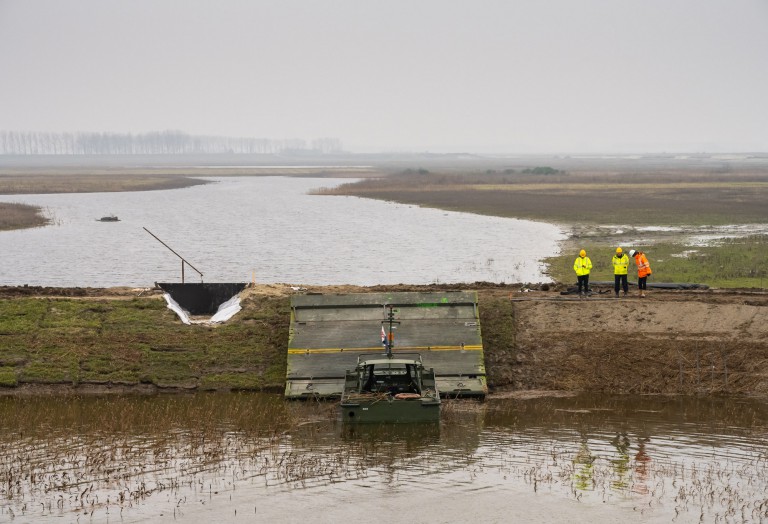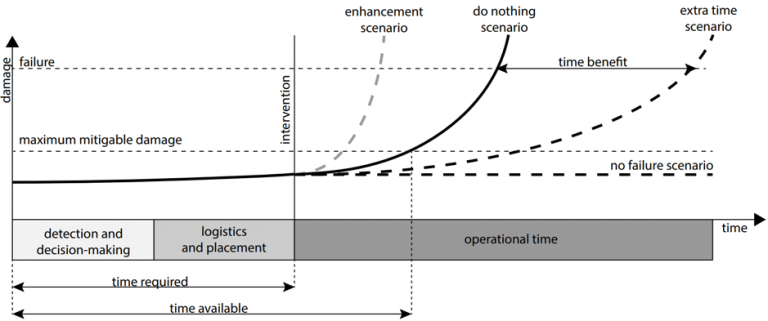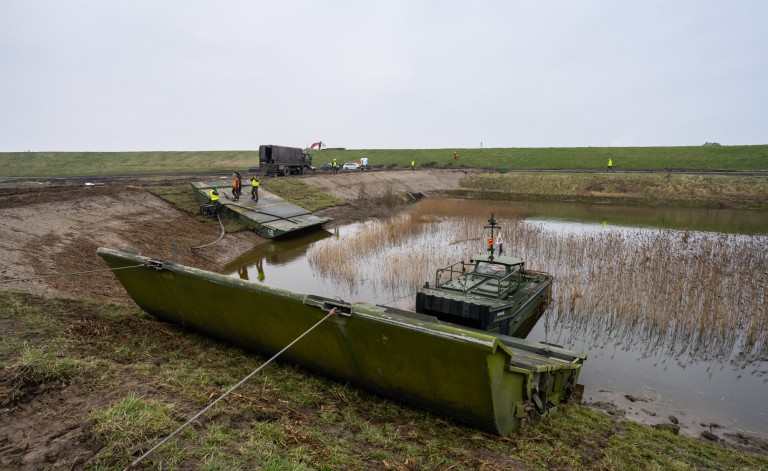Ministry of Defence: positive first results in BreachDefender pilot study
- 07 June 2022
- Francien Horrevorts
- Emergency Response
The concept of the BreachDefender has been tested in real life conditions in the Living Lab Hedwige-Prosperpolder. The BreachDefender is a pontoon, a floating bridge, that can be used to slow down or stop the breaching of a levee in its early stages. The Dutch Ministry of Defence is one of the partners participating in this pilot study and they recently presented the preliminary results.
Marc Balemans, Programme Manager Water Risk Training Expertise centre (WTEc), and Alexander Schmets, Assistant Professor at the Netherlands Defence Academy (NLDA), give some more insight into the departments of the Ministry and the BreachDefender pilot.
Main tasks
The Dutch Ministry of Defence has three main tasks:
- Defend its territories and that of its allies
- Protect and promote the international rule of law and stability
- Support the government
The activities of the Ministry of Defence in the Polder2C’s project relate to the third main task. The Ministry of Defence provides assistance in the event of disasters in the Netherlands. Government authorities regularly call upon the Army for assistance, as they need military materiel or their unique expertise. Examples of necessary assistance are cases of forest fires, pandemics or flooding.

Water Risk Training Expertise centre
The activities concerning flooding are based in the knowledge center of the engineers. They work together with civil partners in the Water Risk Training Expertise centre (WTEc). This is a cooperation of organisations that share knowledge, practice for emergencies and build a network.
Netherlands Defence Academy
Another department of the ministry involved in Polder2C’s is the Netherlands Defence Academy (NLDA). NLDA is comparable to Cranfield in the UK or Westpoint University in the US. They train future officers and army leaders. Their three main study topics are:
- War Studies
- Military Logistics & Management
- Military Technology
The NLDA trains future officers, conducts research, gives lectures and cooperates in research projects such as Polder2C’s. Three pillars are the foundation of education at NLDA: Military Training, Training Leadership and Scientific Training.
BreachDefender pilot
In the Polder2C’s project the Ministry of Defence mainly participates in the field of Emergency Response. One of the tasks concerning this topic is the BreachDefender pilot. The BreachDefender is a floating pontoon that the military usually use to construct a temporary floating bridge.
The purpose of using the BreachDefender in this pilot study is to prevent or postpone a levee breach in its early stages. The inspiration of the concept came from a historical event in 1953 in the province of Zeeland. During a flooding disaster a big vessel was placed onto a breaching levee and by doing so it prevented the breach from increasing. The principal researcher in this project, a collaboration between NLDA and TU Delft, is PhD-student Danny Janssen.
Intervention scenarios
Emergency response strategies can be schematized by various intervention scenarios and what their impact is on arresting the breach development on a levee. This scheme shows the amount of damage as a function of, as well as the different phases that occur when an emergency response intervention is executed. In the same scheme the amount of damage that is irreversible i.e., failure of the levee, is given. Various intervention scenarios will lead to different ‘end states’:
- The enhancement scenario - an intervention may speed up damage growth
- Do nothing scenario – damage will propagate in a natural way (no intervention)
- Extra time scenario - an intervention slows down the damage growth and gives extra time, e.g., to be used for evacuation
- No failure scenario - an intervention leads to the total arrest of the damage process; the levee has become stable and save (with respects to the ‘intervention site’)

The research programme leading to full understanding of the BreachDefender has been addressed at three subsequent length scales: i) laboratory, ii) intermediate length scales (Flood Proof Holland) and iii) realistic length scale (Hedwigepolder, a true pilot study). The outcomes from the research at these three scales combined will provide a complete picture on the usefulness and application scenarios for the Breach Defender. This convergence of various scales is still work in progress.
Two application scenarios were studied in the pilot (realistic length scale) in the Hedwigepolder in February/March 2022. In this polder a water basin, the Hedwigepool, has been built. This testing facility was designed as such that the water levels could be controlled by either pumping water into or out of the pool; this allowed for experiments at full scale and at emergency conditions (i.e., high water levels). The performance of the BreachDefender was subsequently monitored. Firstly, by placing the BreachDefender onto the levee to increase the crest of the levee and reduce the flow rate of water across the levee. Secondly, by testing the scenario where an already existing breach was to be arrested by the BreachDefender.

Preliminary conclusions
The real scale results of the experiments at the Hedwigepool show that the intervention with the BreachDefender reduces water flow very significantly. Currently, the analysis of the data is still work in progress. Also, models are being made to predict the effect of an intervention using the BreachDefender. The preliminary conclusions are that the concept of the BreachDefender works very well, provided a specific work flow is being followed.
Future plans
In the coming years, the Ministry of Defence will explore in cooperation with the Dutch Water Boards whether the BreachDefender concept should become a regular option within the Ministry’s emergency response toolbox, and hence will be part of the regular Emergency Response training exercises.
Apart from the BreachDefender, the Ministry of Defense is also leading the research into controlled (explosive) breach initiation of levees as emergency response method. The Ministry also collaborates on the topic of Mobile Barriers.
Watch full presentation
Interested in more detailed information on this topic? Watch the full presentation.
Read more
To learn more about Ministry of Defence, what they do and their role in Polder2C’s, read the interview with Marc Balemans.
